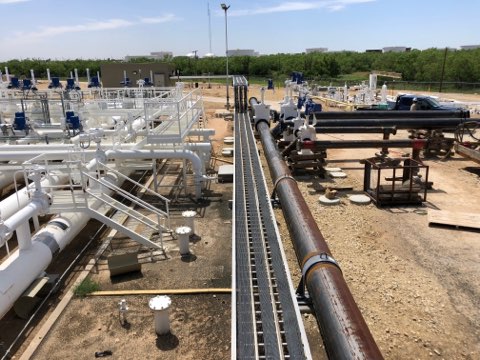All Regarding Oil Field Equipment and Pipeline Equipment: Key Insights and Important Details
Oil field equipment and pipeline systems play a crucial role in the oil and gas industry. They are necessary for the efficient removal and transport of hydrocarbons. Key parts, such as drilling rigs and tank, straight effect functional success. Improvements in technology guarantee to enhance safety and performance. Comprehending these elements is important for any person involved in or curious about this complicated market, as it establishes the stage for much deeper expedition of sector techniques.

Review of Oil Field Equipment
As the demand for oil remains to expand, comprehending the devices made use of in oil areas comes to be significantly necessary. Oil field equipment encompasses a large range of equipment and tools essential for exploration, extraction, and processing. Trick components include drilling rigs, which are critical for getting to oil tanks, and manufacturing devices, such as separators and pumps, that promote the extraction procedure. Superior Rentals midland. Furthermore, storage containers play a considerable duty in holding petroleum prior to transport. Safety tools, including blowout preventers and pressure gauges, guarantees functional safety and performance. Each tool functions cohesively to maximize production and keep efficient operations. Experience with this devices is necessary for experts in the sector to guarantee effective procedures and adherence to safety standards
Sorts Of Drilling Rigs and Their Applications
Drilling rigs work as the foundation of oil extraction procedures, with various kinds created for specific geological problems and functional requirements. The most usual kinds include rotary drilling rigs, which use a turning drill little bit to pass through the planet, and wire device rigs, recognized for their percussion drilling technique. For overseas procedures, jack-up rigs and semi-submersible rigs give stability and support in aquatic settings. Furthermore, directional boring rigs make it possible for drivers to pierce at angles, reaching down payments that are not vertically available. Each rig type has special benefits, optimizing performance and safety and security based on the drilling environment. Choosing the proper gear is vital for taking full advantage of source removal while reducing environmental impact and functional prices.

Essential Pipeline Equipment and Their Features
Pipeline facilities is vital for the transport of oil and gas from extraction websites to refining facilities and end-users. Different crucial tools parts facilitate this procedure. Pipelines themselves act as the primary conduits, designed to endure high pressure and corrosive materials. Pump stations are vital for maintaining circulation by boosting stress along the pipeline. Valves play an important function in managing flow and isolating areas for maintenance. Furthermore, fittings and connectors assure safe joints in between pipe areas. Keeping track of systems, consisting of circulation meters and stress sensing units, are crucial for finding leaks and optimizing circulation rates. Ultimately, pigging devices is utilized for upkeep and cleaning, protecting pipeline stability and additional reading efficiency. With each other, these elements develop the foundation of a dependable pipeline system.
Innovations and Technologies in Oil and Gas Equipment

Security and Upkeep Practices in the Oil Market
While the oil industry has made significant strides in innovation and efficiency, the value of durable safety and security and upkeep techniques can not be overemphasized. Effective safety and security methods are important to shield workers and the setting, lessening the danger of accidents and spills. Routine evaluations and upkeep of equipment assistance identify prospective problems before they escalate, ensuring operational integrity. Training programs for workers are vital, stressing the significance of security awareness and emergency situation feedback treatments. Additionally, adherence to industry laws and requirements fosters a society of safety. Applying innovative monitoring modern technologies can better boost maintenance methods, permitting real-time evaluations of equipment problems. Inevitably, focusing on security and upkeep is important to the sustainability and success of the oil market.
Often Asked Inquiries
What Are the Ecological Influences of Oil Field Equipment?
The ecological influences of oil field equipment linked here consist of habitat devastation, water contamination, and air contamination (Superior Rentals midland). Furthermore, equipment breakdown can bring about spills, adversely affecting wildlife and ecological communities, highlighting the demand for strict policies and tracking
Exactly How Is Oil Field Equipment Moved to Remote Locations?
Carrying oil field equipment to remote places typically entails specialized automobiles, helicopters, or barges. Logistics business coordinate paths, making sure tools shows up securely and successfully, thinking about surface and ease of access to decrease delays and take full advantage of efficiency.
What Regulative Specifications Govern Oil Field Equipment?
Regulatory requirements controling oil field equipment mainly consist of safety, environmental security, and functional efficiency standards. Agencies such as OSHA and EPA implement these laws to assure secure practices and minimize eco-friendly effect in oil removal operations.
What Abilities Are Needed to Operate Oil Field Equipment?

How Do Oil Costs Influence Equipment Demand and Use?
Oil rates considerably influence equipment demand and usage. Greater rates generally bring about increased expedition and production tasks, driving need for equipment. Alternatively, reduced costs might result in reduced procedures and reduced requirement for tools.